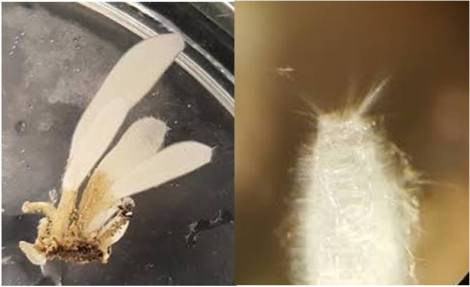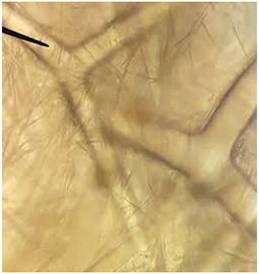
Figure 1: (left) An image of the Leucilla nuttingi sponge I examined. The body of the sponges are tube-like and the oscula are located at the top corner of the picture. Photo: Natasha Ekasumura… and (right) A close-up of the osculum showing the hair-like nature of the oscular fringe. Photo: Michaela Rohrbough
A week ago in lab I got to look over Leucilla nuttingi, one of the few calcareous sponges present off the coast of California. Calcareous sponges differ from other types of sponges in that their structural elements, known as spicules, are made of calcium carbonate instead of the more common silicon dioxide. Interestingly, the members of class Calcarea also lack spongin, the fibrous but elastic tissue we normally associate with sponges.
One of the first things I noticed while taking a closer look into Leucilla were the small, hair-like structures protruding in a ring around the oscula, (the large opening at the top of the sponge which allows water to flow outward). Under higher magnification, I recognized these hairs were in fact long, thin spicules scattered among the larger three-pronged “triradiate” spicules characteristic of this group.

Figure 3: an image of Leucilla’s spicules at 400X magnification. The image clearly shows the larger triradiate spicules (one of the two is indicated by the pointer in the image), and the many, tiny filamentous spicules which act as sensory structures in certain parts of the sponge. Photo: Natasha Ekasumura
It turns out that Leucilla nuttingi has many different kinds of spicules. I identified the thin ones as “Micro-Oxeas” (Lee et al. 2007). While the main function of triradiates is to provide support, these thin spicules do not play much of a structural role in the sponge. As I had noticed, however, they do make up the majority of the “collar” surrounding the osculum, called an oscular fringe. (BotRejectsInc 2007). This begged the question: what is their function?
Sensory-driven contraction of the osculum can also be used to expel harmful substances, such as sediment, out of the sponge thereby keeping the inner lining of the sponge from becoming clogged or injured. This “sneeze” is caused by ciliated epithelial cells around the interior of the osculum. Each cell has one large cilium that protrudes straight out of cell and responds to external forces much the same way that the micro-oxeas spicules do. The high surface to volume ratio of the cilia also make it an ideal sensory organelle. These ciliated cells are only present around the osculum, and because they are so plentiful in this region, some consider the osculum to be a sensory organ. (Ludeman 2014). While sponges are considered to have no nervous system because they have no brain or neurons (cells specialized for conducting electrical signalling), it is clear that sponges react to their environment and the different cells in the sponge can communicate with each other, suggesting that perhaps sponges are not as simple as we think.
Sponges have no nervous system, but they can still respond to changes in environment, such as changes in temperature. They also respond to injury. The osculum is one of the most sensitive parts of the sponge, and the ring of spicules surrounding it may help to detect danger. Movement of the micro-oxeas spicules triggers the osculum to contract and protect the sponge. (BotRejectsInc 2007). But I wanted to know more about now this works. Sponges have specialized cells called myocytes that can contract to close the osculum. (Jacobs et al. 2007). The spicules and the myocytes can communicate using chemical and electrical signalling, much like the nervous systems of other metazoans. (Renard et al. 2009)
References:
BotRejectsInc (2007, January 28). Sponges (Porifera, Poriferans)-Cronodon. Cronodon. Retrieved January 14, 2016, from www.cronocodon.com/files/Sponges
Jacobs DK, Nakanishi N, Yuan D, Camara A, Nichols SA, and Hartenstein V (2007) Evolution of sensory structures in basal metazoa. Oxford Journals: Integrative and Comparative Biology 47 (5): 712-723.
Lee W, Elvin DW, Reiswig HM, Monterey Bay National Marine Sanctuary SIMOM Staff (2007) Leucilla nuttingi. pp. 219. The Marine Sponges of California: Key to California Porifera.
Ludeman DA, Farrar N, Riesgo A, Paps J, and Leys SP (2014) Evolutionary origins of sensation in metazoans: functional evidence for a new sensory organ in sponges. BMC Evolutionary Biology 14:3 (publisher ludeman et al. lincensee biomed central ltd)
Renard E, Vacelet J, Gazave E, Lapebie P, Borchiellini C, and Ereskovsky AV (2009) Origin of the neuro-sensory system: new and expected insights from sponges. Integrative Zoology 4: 299-308.